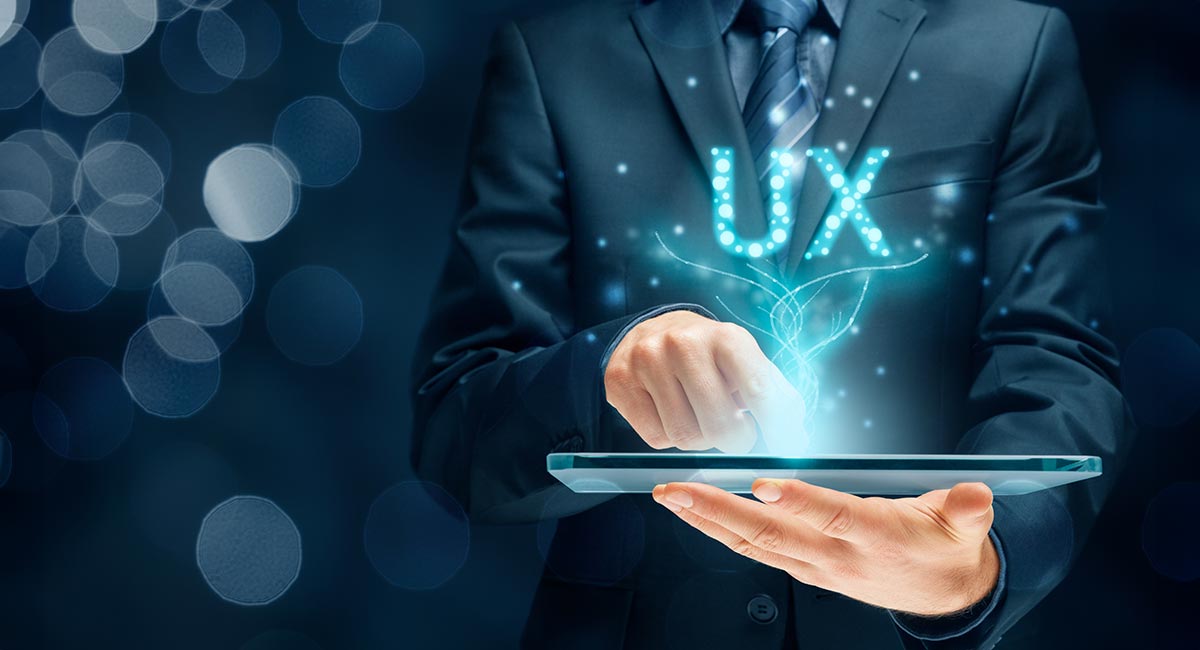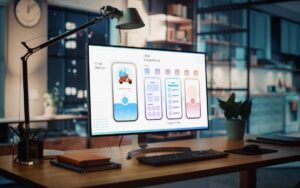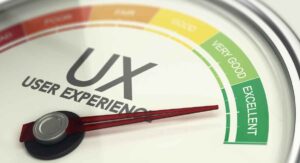UI/UX design is a fast-moving field, presenting exciting opportunities and challenges for digital product creators. A deep understanding of user behavior is essential if you want to make your mark in this industry. You also need a keen eye for the changes – what new best practices are arriving on the scene? What are the biggest headwinds?
In this article, we’ll delve into the top UX/UI design trends in 2025, offering insights and strategies to help aspiring designers stay ahead of the curve. Additionally, we’ll highlight how a comprehensive UI/UX design program can equip you with the skills and knowledge needed to thrive in this ever-evolving industry.
How is the Future UI/UX Design Shaping Up in 2025
Today, when people spend many hours on their mobile phones daily, having a functioning and streamlined UI/UX that works uniformly across all devices is imperative for enterprises. Businesses require UI/UX designers who can creatively design universally presentable and appealing products. It is this creative thinking that leads to the evolution of new trends.
The current focus is on making digital products and services more flexible, user-friendly, inclusive, and accessible. With most people preferring videos, UI/UX designers are devising multiple ways and formats to add videos and animations to their applications. Further, using AI to automate user-based customization has taken the main stage, with 54 percent of the users preferring personalized content.
All of these point in one direction: The UI/UX landscape constantly evolves and brings new technologies into the fold. So let’s dig into top UI/UX design trends for 2025.
Top 10 UI Design Trends of 2025
1. Creative motion design
Creative motion graphics have become the rage as UI designers can combine accessibility, usability, and the aesthetics of the interfaces. The creative motion design implements the feature of motion to text, images, audio sections, and video elements.
2. 3D interactive objects
There has been an increase in the demand for 3D objects in UI to enable a 360-degree visualization of the product. UI designers can include interactive elements within the 3D objects. For example, a real estate website may display the 3D model of a house on sale with a UI design that enables them to open the door and get an online walk-through.
3. Generative design
UI designers have begun adopting AI to craft UI elements that evolve and alter as per user preferences. AI algorithms provide iterations of typography, layouts, color schemes, and content elements. For example, Microsoft PowerPoint offers multiple design options for slides.
4. Landing page with features
The UI design of the landing pages dictates the conversion rate. The landing page must captivate the audience and egg them on to browse the products. Consequently, UI design displays the key product features on the landing page rather than forcing the audience to find their way through the Products tab. The landing page must also be universally compatible because a mobile-responsive landing page has a higher conversion rate than a desktop-responsive one
5. Scrollytelling
Scrollytelling is formed from the words ‘scroll’ and ‘storytelling.’ Scrollytelling works by dividing the main article into sections that disappear and are replaced by the proceeding sections as the audience scrolls down the page. The dynamic screen showcasing the integration of images, animation, gifs, and videos is crucial to capturing and retaining the audience, especially when the attention span of humans has dropped from 12 seconds to eight since 2000. It’s no coincidence that this corresponds with the widespread adoption of mobile phones.
6. Hero sections
The hero section is that part of the landing page that the audience sees first when they visit a website. It includes a main background or foreground graphic representing the brand, with a short introduction and a CTA button. The goal is instantly connecting with the user with bold, concise, and minimalist phrases.
For example, on the Joe’s Café Dubai website, a beautiful video of a fountain is adjacent to the caption “Dining with a view”. It provides a brief introduction to the venue and offerings of the café. Last, a CTA button asks the user to reserve a table.

7. Typography
Typography has evolved in many ways, from artistic to legible to colorful. In 2025, typography is set to become capitalized, large, and bold. Gone are the days of subtle and delicate font. The websites are now trying to get the message out loud, clear, and minimalistic.
8. Glassmorphism
Glassmorphism involves creating glass-like elements in the graphics to indicate the different levels of text. The elements have a frosted-glass appearance with a transparent foreground on a blurred background. The translucent objects have a glowing border.
9. Parallax scrolling
Parallax refers to an effect with a visible difference in the planes of two or more objects on a screen. When this effect is applied to scrolling, the user can see multiple planes just by scrolling 360 degrees. For example, if the website features a set of drawers, the parallax scrolling helps the user view the top and sides by scrolling up, down, or sideways.
10. Mix of visuals
Sometimes, UI designers can include two or more types of visuals. Applications may have collages, sketches, calligraphy, photos, text, and videos without a fixed uniformity. The color scheme, font type, size, and shape of images can vary. However, they are all woven into the story on the page to seem coherent.
Top 10 UX Design Trends of 2025
1. Cross-platform UX
With the advent of devices of new shapes and sizes, enterprises want to be visible and accessible everywhere. For example, YouTube, which ran a desktop or long-video format, introduced ‘Stories.’ Stories are compatible with a mobile screen and can be shot and uploaded directly from a mobile phone.
2. Augmented Reality
Users want to experience a product before buying it. Virtual reality and augmented reality enable UI/UX designers to integrate such experiences for the users. The collaboration between Gucci and Snapchat is a great example. Users can select a shoe pair and use the Snapchat camera to focus the Gucci Lens on their feet. The Lens shows how the shoes would look on the user’s feet.
3. Accessible design
Accessibility is an ethical and legal requirement and helps expand the brand’s reach. UX designers have begun to include accessibility elements in the wireframe and prototype. Features such as text-to-sound, voice-to-text, auto-translation, simultaneous translation, touch sensors, braille-enabled features, and customized color and light schemes will make a regular appearance in 2025.
4. Ethical design
This UX design trend entails including the system’s data security and privacy aspects within the UX wireframe rather than a separate addition as an afterthought. Data transparency is crucial to build user trust. UX/UI designers utilize encryption, multi-level authentication, and data recovery aspects in the core design stage.
5. Brutalism
Brutalism refers to a UX design trend opposite to the usual colorful and elaborate designs. Brutalism uses raw, unconventional, and bold typography. The focus is on the code and functionality rather than the aesthetics. Designers employ a color scheme with starkly contrasting colors. Basic block structures and straight lines are the norm.
6. Hyperrealism
entails designing detailed, life-like objects and mimicking real-world objects. The designers use advanced techniques to render 3D models and animations from photos. The focus is to induce the user to feel they get what they have seen.
7. Location-based UX
With the reach of a website growing beyond borders, location-based customization of the UX is on the rise. For instance, there are options to translate the language of the website. Further, the products change based on location. For example, the McDonald’s website displays different burgers if you open it in France than those on the website customized for Thailand. AI will be used to explore this aspect further in 2025.
8. Advanced cursor interactions
Cursor is the primary tool that enables all the UI and UX experiences to actualize. Designers design cursors with different designs, shapes, colors, and animation. Further, designers have created cursors that reveal snippets of information, change the text color, or add elements. The website Cyberseek is a great example, where hovering over a particular certification name reveals arrows that show its relation to the job titles.

9. Metaverse
Metaverse is an immersive experience where users can interact in a virtual space in real time. The designers create personas and environments that resemble the real world. Technologies such as augmented and virtual reality have become the focus. Additional field research and a collaborative effort are required for the metaverse to evolve further in 2025.
10. Microinteractions
Microinteractions are momentary visual features that make the UX more fun. For example, changing the ‘Submit’ button to a loading circle on a click takes the boredom out of waiting for the submission. This requires detailing in the imagery and illustrations. The ‘eye’ symbol next to a password box is another example. Using GIFs is also a part of micro-interactions.
How UX/UI Certifications Help to Stay on Top of Trends and Best Practices
User interface and experience design is a dynamic landscape that requires professionals to keep themselves updated with the upcoming UI/UX design trends. They must also be splendid researchers to explore ways to utilize technologies and concepts. Being a tech nerd is, in fact, an advantage, there are always new tools and software in the market.
Thus, continuous learning is a mandatory aspect of UI/UX design. While you may conduct personal research, you may need to learn the technicalities of the tools from online resources such as specifically curated courses and programs. A future-ready UI/UX design course provides an all-encompassing view of the current UX/UI industry. You can learn the highs and lows of the UI/UX designing process from industry experts. Such a bootcamp also gives you practical exposure to the industry’s major tools and UX design trends.
Such online resources increase your skills and connect you to your peers. You can earn more and deliver an enhanced work performance. Certifications add to your credibility, and employers will notice you when you work on industry projects as a part of the bootcamp.
Master the Skills and Tools to Become a Successful UI/UX Designer
If you’re a creatively inclined tech geek, the world of UI/UX designing might be the right career path for you. You can explore your love for art and aesthetics while writing code and using tools to bring your imagination to life. A comprehensive UI/UX design bootcamp can help you acquire the skills and knowledge needed to enter this field.
The bootcamp acquaints you with the top design tools such as Figma, Invision, and Balsamiq. You will interact with industry experts in live sessions and build your Dribbble portfolio to showcase your skills. Take this opportunity to learn about UX/UI principles and work on Capstone projects to jump-start a lucrative career.






